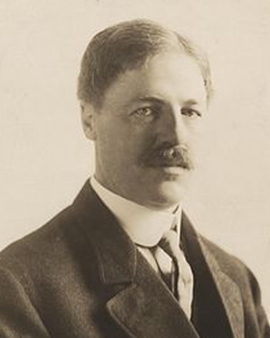With sparkling eyes, Frank Weston Benson, born March 24, 1862, looked at the world and translated his observations into an impressive collection of realistic portraits, impressionistic paintings, watercolors, and etchings. From the depths of Salem, Massachusetts, his passion for art grew, coupled with an unparalleled talent that gave him access to the venerable halls of the Library of Congress. There, he began his career painting portraits of renowned families as well as grand murals. Benson's ability to revere and preserve nature is reflected in many of his works, whether through his depiction of wild birds or in paintings of his daughters set in the pristine surroundings of his summer home, Wooster Farm on North Haven Island, Maine.
The formative phase of Benson's artistic development began in 1880 at the School of the Museum of Fine Arts in Boston, where he studied under Otto Grundmann and Frederic Crowninshield. His thirst for knowledge and artistic improvement led him to Paris in 1883, to the prestigious Académie Julian. Benson not only developed his skills as an artist, but also shared his knowledge and enjoyed an illustrious career as a lecturer and department head at the School of the Museum of Fine Arts in Boston. His prominence in the arts was highlighted by his role as a founding member of Ten American Painters, the American Academy of Arts and Letters, and the Guild of Boston Artists.
In his early childhood, shaped by the maritime experience of his grandfather, Captain Samuel Benson, his appreciation for the sea developed. At age 12, he received his first sailboat and began exploring the waterways and marshes while competing in friendly contests with his brother, John Prentiss Benson. Benson's parents encouraged this independence and education by giving their children a weekly allowance to enable exploration and learning. These beginnings are reflected in Benson's fascination with depicting wild birds in his works. It was as if through each art print he honored the animal kingdom and preserved its beauty for posterity. Benson's early enthusiasm for bird watching and wild bird hunting led him to want to become an ornithological illustrator. At 16, he painted "Rail," one of his first oil paintings, after a hunting trip. During his college years, he befriended like-minded artists such as Joseph Lindon Smith, Robert Reid and Edmund Charles Tarbell. Benson used his newly learned knowledge to teach drawing classes in Salem while painting landscapes during the summer months.
Benson said goodbye to the world on November 15, 1951, and his final resting place is the picturesque Harmony Grove Cemetery in his beloved hometown of Salem. But the power of his artistic influence and the memory of his art did not fade with his physical departure. In the years that followed, Benson's works received the recognition and value they deserved after his death. His work posthumously became a showcase for auction houses, which emphasized the value of his visionary art. A stunning oil painting by Benson changed hands for $4.1 million at Sotheby's in 1995, a testament to his enduring influence and importance in the world of art.
The fascination with Benson's work was evident in one particular event in 2006, when an anonymously donated watercolor of his sold for $165,002 at an Oregon Goodwill Industries auction. What began with modest bids of $10 rose exponentially when the work was authenticated, proving once again that Benson's art continues to be sought after and appreciated. Benson's paintings, now reproduced as the highest quality fine art prints, allow art lovers to experience the charm and beauty of his vision in their own spaces. They are a living legacy, continuing the stories he told through his art, and a reminder of the passion and commitment he put into his work. This is how Frank Weston Benson, a master of his craft, lives on in the collective memory and hearts of those who were inspired by his art.
×





.jpg)
.jpg)
.jpg)
.jpg)
_-_(MeisterDrucke-1400092).jpg)
_-_(MeisterDrucke-1400092).jpg)
.jpg)
.jpg)
.jpg)
.jpg)
.jpg)
.jpg)
.jpg)
.jpg)
_-_(MeisterDrucke-1450001).jpg)
_-_(MeisterDrucke-1450001).jpg)
_-_(MeisterDrucke-1497045).jpg)
_-_(MeisterDrucke-1497045).jpg)
.jpg)
.jpg)
.jpg)
.jpg)
.jpg)
.jpg)
.jpg)
.jpg)
_-_(MeisterDrucke-1507466).jpg)
_-_(MeisterDrucke-1507466).jpg)
.jpg)
.jpg)
.jpg)
.jpg)
.jpg)
.jpg)
.jpg)
.jpg)
_-_(MeisterDrucke-1417693).jpg)
_-_(MeisterDrucke-1417693).jpg)
.jpg)
.jpg)
_-_(MeisterDrucke-1404302).jpg)
_-_(MeisterDrucke-1404302).jpg)
.jpg)
.jpg)
.jpg)
.jpg)
.jpg)
.jpg)
.jpg)
.jpg)
.jpg)
.jpg)
.jpg)
.jpg)
_-_(MeisterDrucke-1494934).jpg)
_-_(MeisterDrucke-1494934).jpg)
.jpg)
.jpg)
.jpg)
.jpg)
.jpg)
.jpg)
.jpg)
.jpg)
.jpg)
.jpg)
.jpg)
.jpg)
.jpg)
.jpg)
_-_(MeisterDrucke-1508820).jpg)
_-_(MeisterDrucke-1508820).jpg)
_-_(MeisterDrucke-1448425).jpg)
_-_(MeisterDrucke-1448425).jpg)
_-_(MeisterDrucke-1417788).jpg)
_-_(MeisterDrucke-1417788).jpg)
.jpg)
.jpg)
.jpg)
.jpg)
.jpg)
.jpg)
.jpg)
.jpg)
.jpg)
.jpg)
.jpg)
.jpg)
.jpg)
.jpg)
_-_(MeisterDrucke-1453560).jpg)
_-_(MeisterDrucke-1453560).jpg)
.jpg)
.jpg)
.jpg)
.jpg)
.jpg)
.jpg)
_-_(MeisterDrucke-1403557).jpg)
_-_(MeisterDrucke-1403557).jpg)
.jpg)
.jpg)
.jpg)
.jpg)






